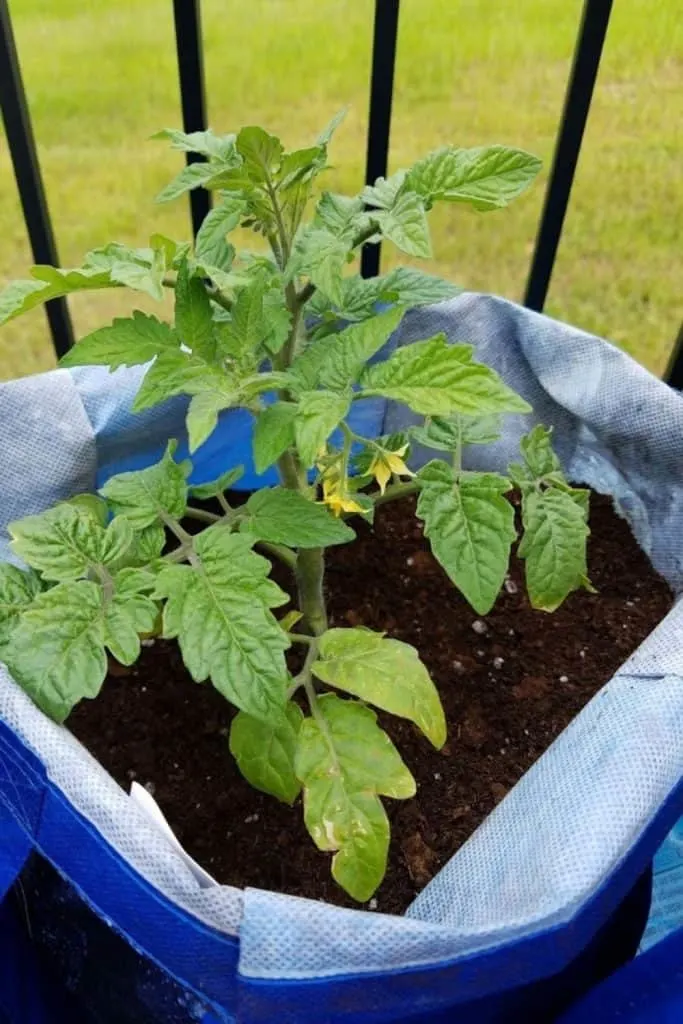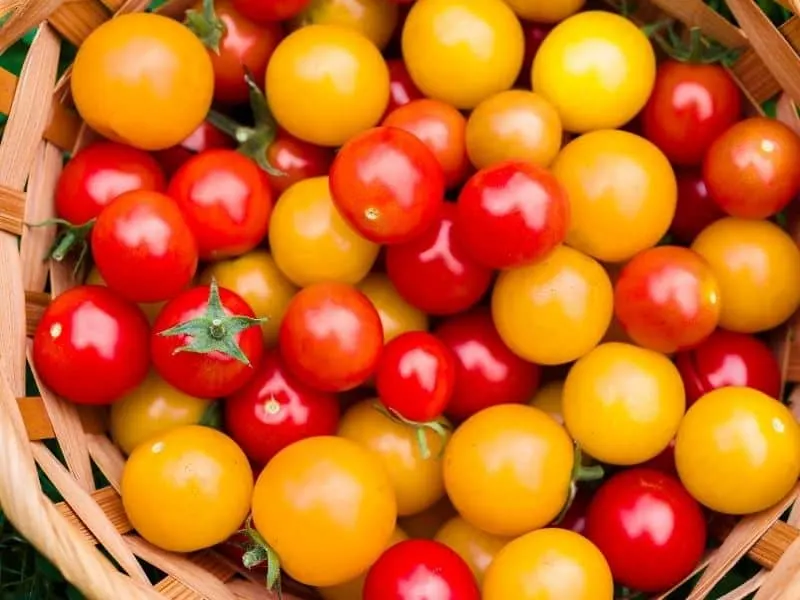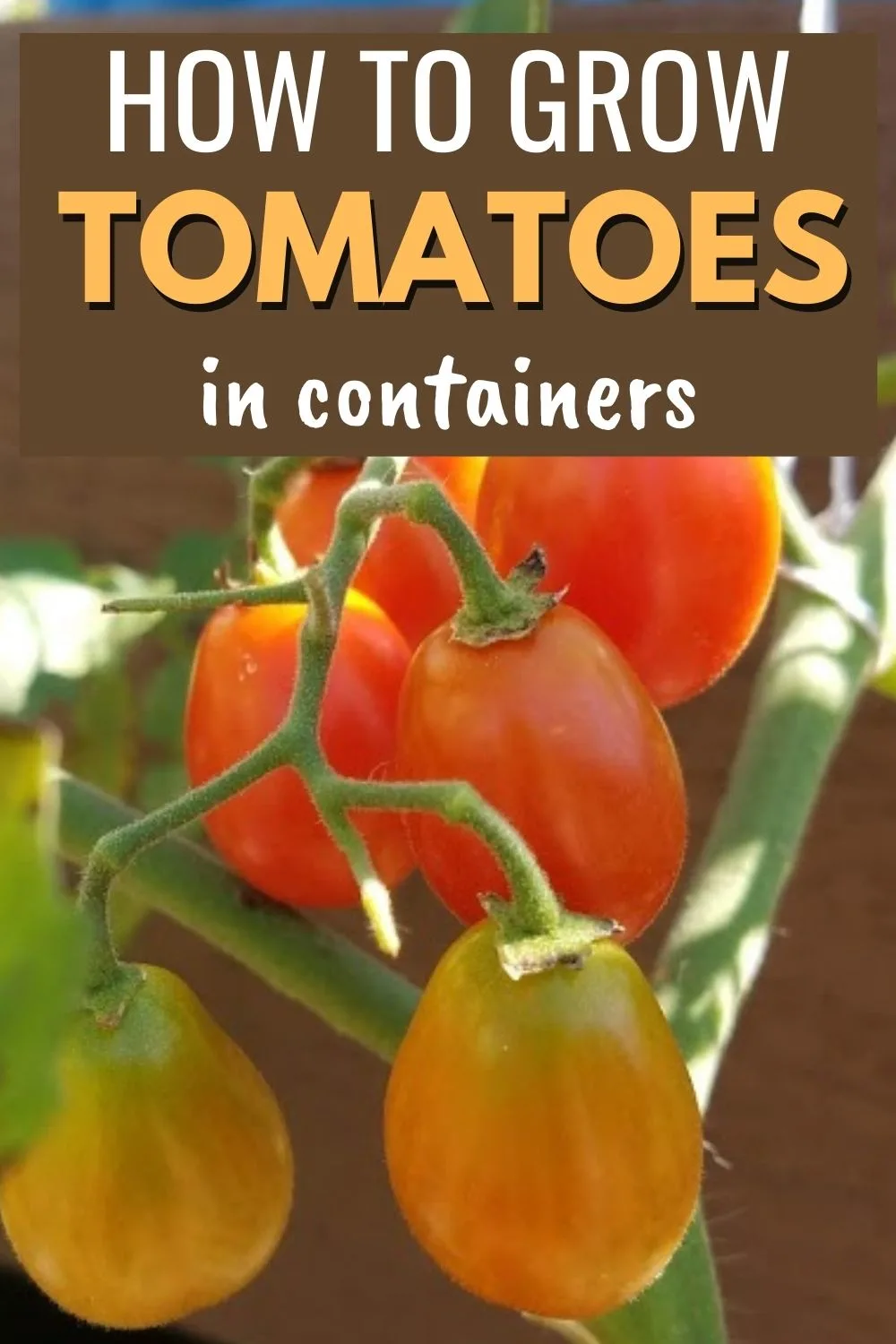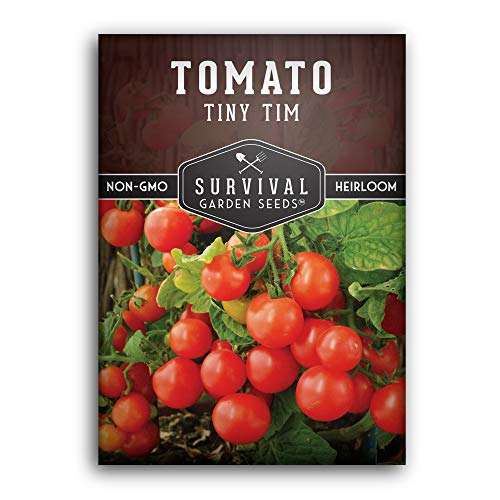Tomatoes are one of the easiest and most popular vegetables to grow in containers. Once you learn how to grow tomatoes in containers, you can harvest the plump red fruit from the convenience of your porch, balcony, or patio.

How to Grow Tomatoes in Containers
Growing tomatoes in containers requires choosing the right soil, container, and even tomato variety, as well as properly caring for the plant.
With all the work and money that goes into it, why grow tomatoes in containers?
Advantages of growing tomatoes in containers
First, it actually makes maintenance easier. Potted plants typically remain weed-free, and they can be placed close to a door, making them easily accessible for pruning, watering, or plucking off a ripe tomato to slice up for lunch.
Second, many tomato maladies can be prevented with good airflow, which is easy to achieve with well-spaced individual pots with good drainage.
Placing containers on a balcony, deck, or porch also often keeps the plants out of reach of pests like deer, groundhogs, and rabbits.
Planting and Staking Tomatoes in Containers
A single, well-cared-for vine can produce a significant amount of fruit. So while you can stick just about any tomato plant in just about any container and get a few tomatoes from it, for a bountiful harvest, follow the following tips to keep your vine healthy and happy.
1. Choose the right type of tomato
There are two categories of tomato plants: determinate and indeterminate.
Determinate tomatoes grow only to a certain height, flower and ripen more quickly, and produce tomatoes for about four to six weeks.
Indeterminate tomatoes, on the other hand, continue to grow taller and produce fruit until the first heavy frost, making them a bit large and unwieldy for container gardening. So although indeterminate tomatoes can be grown in pots, determinate varieties are recommended.
If you want to grow only one or a few plants, or this is your first foray into container gardening, purchase healthy seedlings from a local greenhouse rather than attempting to start your tomatoes from seed. Here are a few varieties that grow well in containers:
Tiny Tim
An heirloom dwarf cherry tomato, Tiny Tim grows to just eight to 16 inches tall and produces small, red fruit within 60 days.
Tumbling Tom
With its trailing growth habit, Tumbling Tom is perfect for hanging baskets. This hybrid cherry tomato grows six to eight inches tall but will trail as long as 30 inches and is available in red and yellow varieties.
Matures in 63 to 70 days.
Micro Tom
Although possibly the world’s smallest tomato plant at just six to eight inches tall, Micro Tom is surprisingly productive. This heirloom vine produces red cherry tomatoes within about 60 days.
Bush Early Girl
The six- to seven-ounce slicing tomatoes on this compact hybrid begin ripening after about 54 days. Each three-foot plant produces about 100 tomatoes in ideal conditions.
Silvery Fir Tree
With silvery, carrot-like foliage, this two-foot-tall Russian heirloom doubles as an ornamental plant. It produces large crops of red three- to four-inch fruits within about 60 days.
Patio
This two-foot hybrid variety produces a good crop of red three- to four-ounce tomatoes within about 70 days.
More container favorites
We planted these sun sugar tomatoes for the first time this year and they were the best tomatoes ever!
Another all-time favorite is the sweetie cherry tomato. An indeterminate, it produces an abundance of tomato clusters in 75 days. YUM!
And if you want a delicious colorful tomato salad, you must add some black zebra cherry tomatoes and yellow pear tomatoes. All of these tomatoes are full of flavor and unlike any other tomatoes you ate from the store.
Learn about the best cherry tomatoes to plant.
2. Best containers for growing tomatoes
With such a wide range of tomato varieties suited to container gardening, it’s important to match the right container with the right tomato plant.
First, consider how big the tomato plant will be at maturity. A tiny, six-inch Micro-Tom plant may fit comfortably in a six-inch pot, but something larger like a Bush Early Girl will require five to ten gallons of soil. Though not elegant, a food-grade five-gallon bucket works quite well.
Plants two feet or shorter will even grow in a hanging basket, with their vines trailing down over the edges for easy harvest.
Whatever size pot you choose, the most important factor is drainage. Make sure the container has holes in the bottom, whether you purchase it that way or drill them yourself.
Material matters less, though if you live in an area with especially hot summers, black plastic might get too warm. Choose a lighter color plastic, ceramic, terra-cotta, or fabric container, keeping in mind that the latter two may require more water due to their porous nature.
3. Planting mix for tomatoes in containers
Use good quality potting soil and/or compost for best results. The University of New Hampshire Cooperative Extension recommends a soilless potting mix, usually composed of peat or coir (the latter being more eco-friendly) and perlite or vermiculite. These lightweight mixes simultaneously retain moisture and improve drainage of excess water, ensuring your tomato plant receives sufficient hydration without becoming waterlogged. Alternatively, try mixing equal parts compost, coir, and perlite.
Dr. Earth Organic 5 Tomato, Vegetable & Herb Fertilizer Coco Bale 5 kg 100% Coconut Coir Fibers
Coco Bale 5 kg 100% Coconut Coir Fibers Horticultural Perlite – All Natural Soil Additive – Improves Drainage, Aeration, and Growth
Horticultural Perlite – All Natural Soil Additive – Improves Drainage, Aeration, and Growth
To encourage healthy growth and high yields, begin fertilizing two weeks after planting your tomatoes. Tomato plants use phosphorous in flowering and fruiting, so choose a soluble fertilizer with a higher middle number (which indicates the ratio of phosphorous), such as 5-10-10.
I recommend using an organic fertilizer, especially for vegetable plants. A mixture of fish emulsion, greensand, kelp meal, and bone meal also works well.
4. Planting your tomatoes in containers

Once you’ve gathered all the necessary materials, it’s time to plant your tomatoes. Taller tomato plants, like Bush Early Girl (see above list of recommended varieties) will need some kind of support to keep the stems from breaking under the weight of their fruit, so make sure to have that on hand, too.
Wire tomato cages work especially well for containers since they help keep most of the branches contained, though a sturdy wooden stake can also be used: it really comes down to personal preference. Either way, putting the support in place when you plant the seedling prevents damaging the roots by trying to add it later.
Learn more about staking tomatoes here.
When you place your tomato seedling in the soil, be sure to scoop out a deep hole. Cover at least the bottom portion of the stem or up to two-thirds of it to encourage extra root growth; tomatoes can grow roots from their entire stem, so don’t worry about suffocating it.
Make sure to wait until after the last frost date in your region to plant your tomatoes, and keep an eye on overnight temperatures for a few weeks after you set them out. If a late frost is forecasted, swaddle the pots in blankets and cover the plants with old bedsheets beforehand.
5. Caring for container tomatoes
For the most part, your tomato plants will be happy with two simple things: ample sunlight and sufficient water. For the first, place the pots in a location that receives at least six to eight hours of sunlight per day. Watering takes a bit more effort, but it will quickly become routine. A consistent watering schedule will help prevent problems like cracking or blossom end rot.
Check the soil twice per day — preferably in the early morning and late evening, to reduce evaporation — and water the plants as needed to keep the soil moist but not wet. To do this, press your finger about an inch into the soil, or up to your first knuckle. If the soil feels dry, give the plant a good drink. Be careful not to splash the leaves, as this can introduce diseases.
While you’re watering, check the plants for signs of pests and diseases, such as nibbled, speckled, or wilting leaves, and take appropriate action if you notice any.
You may also want to prune your tomatoes to increase air circulation, improve the quality of fruit growth, and help keep the plants looking neater. To do this, prune each plant to three or four main stems by removing suckers (new growth where a leaf joins the main stem).
Additionally, if you chose to use an indeterminate variety, pinch off the top of the plant once it reaches the maximum desired height; otherwise, you could end up with an eight-foot plant on your balcony!
If your tomato plant is in trouble, take a look at my guide on saving a dying tomato plant.
6. Harvesting your container tomatoes

Here’s the best part: the burst of a freshly picked, sun-warmed tomato on your tongue. For the best flavor, pick your tomatoes only after they’ve fully ripened on the vine. If you accidentally pick or knock off an under-ripe tomato, just set it on the counter or windowsill to continue ripening.
The counter is actually the best place to store ripe tomatoes as well, as putting them in the refrigerator will cause them to become mealy and lose flavor. Eat them within a few days, though, or they will start to go bad. If you end up with more tomatoes than you can eat or give away, pop them whole and unpeeled into the freezer to chop up later for winter recipes or, if you have enough, can a small batch of salsa or tomato sauce.
Once your tomato plants stop producing fruit or the first hard frost hits, remember to clean out the pots. Discard the plants themselves in a weed pile or the yard debris bin, along with any potting soil that held diseased plants.
All other potting soil can go in the compost bin, though you may want to pasteurize it first by leaving it to bake in the sun in a black plastic bag for a week.
Wash the containers before putting them away for winter to ensure you start with clean pots for next year’s container garden.
At the end of the season, you might want to check these ideas on what to do with green tomatoes.
Disadvantages of Growing Tomatoes in Containers
While there are many good reasons to grow tomatoes in containers, there are also a few disadvantages. The biggest, perhaps, is the cost. Pots, soil, fertilizer, and the plants themselves all need to be purchased to obtain a few tomatoes over the summer.
But if you reuse containers you already have on hand or find some cheaply (think yard sales and thrift stores) and choose a tomato variety with large yields, you can reduce the cost somewhat and increase the payout. Using your own compost in the soil mix or as fertilizer also helps.
The other disadvantage is that potted tomatoes require more frequent watering since the soil in containers dries out faster than the ground. Tomatoes planted in a garden require watering only a few times per week, whereas those in containers typically need water once or twice a day.
Despite these disadvantages, you may find growing tomatoes in containers quite enjoyable. The benefits can far outweigh the costs, especially if you don’t have space for a traditional garden. Besides, what can beat fresh, sun-ripened tomatoes just outside your back door?
I hope you now know how to grow tomatoes in containers, for a quick snack off the porch, or an addition to your salads. But if you have room, and especially if you’d like to preserve some of the tomato goodness for winter, don’t forget to plant some of the meatier tomatoes in your garden. Here’s all you need to know about growing tomatoes.









How To Make Tomato Plants Grow Faster - 13 Easy Tips
Tuesday 20th of June 2023
[…] How to grow tomatoes in containers […]
What Is The Best Soil Mix For Tomatoes?
Monday 17th of April 2023
[…] best results with container-grown tomatoes, place them in a plant tub with a water reservoir. As an alternative, you can also use an automatic […]
How Far Apart To Plant Tomatoes For Better Yield
Monday 27th of February 2023
[…] Learn more about how to grow tomatoes in containers. […]
How To Grow Bell Peppers For Delicious Summer Flavor
Friday 25th of November 2022
[…] how to grow tomatoes in containers […]
9 Easy Garden Crops For Instant Gratification
Wednesday 23rd of February 2022
[…] how to grow tomatoes. Or, if space is a problem, you can grow tomatoes in […]